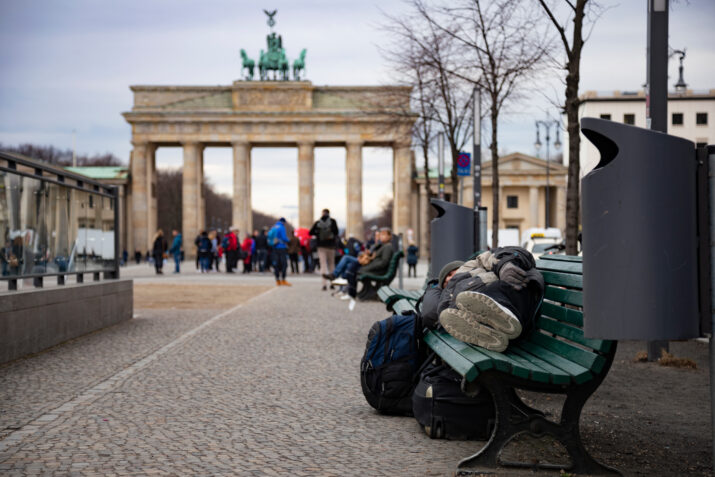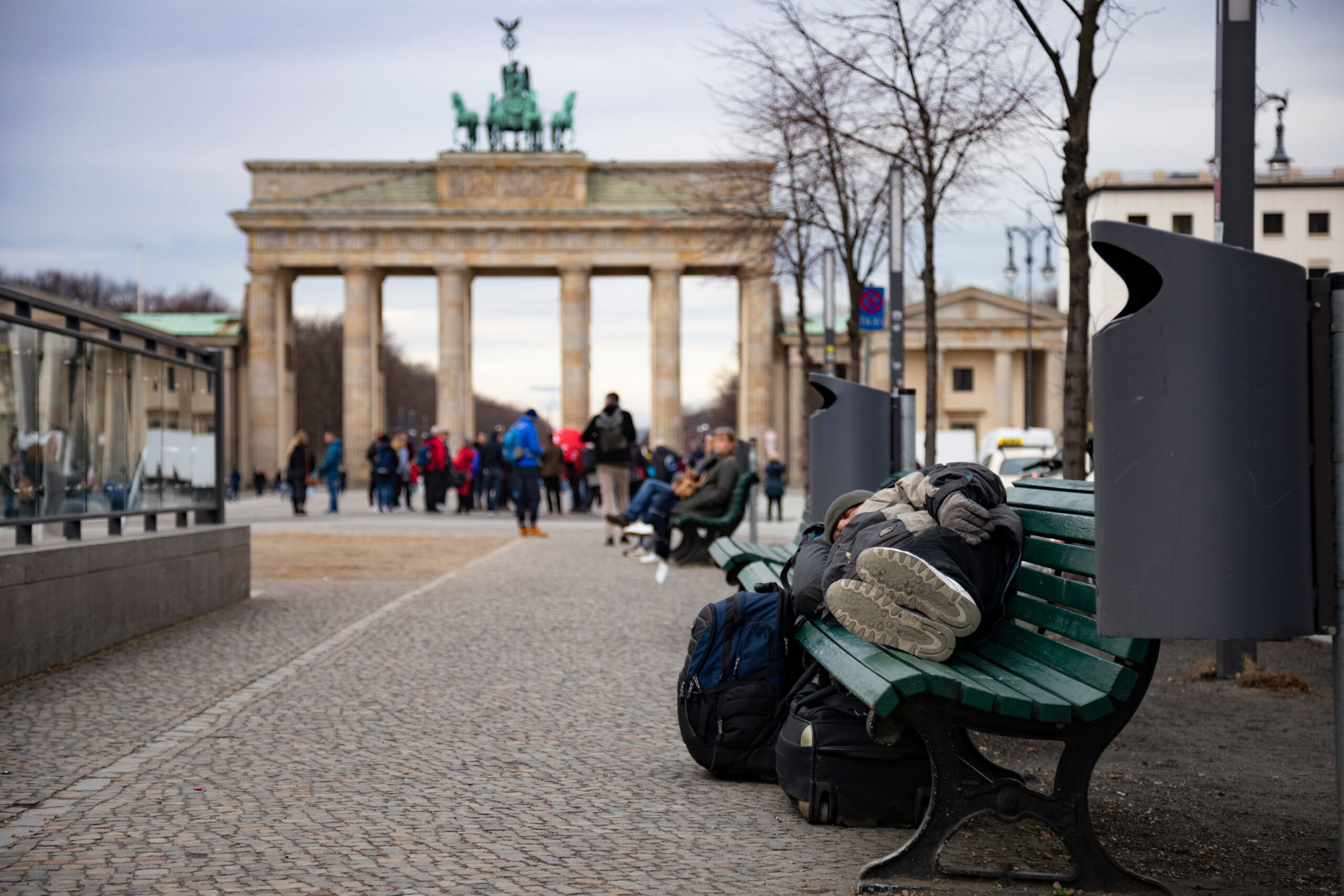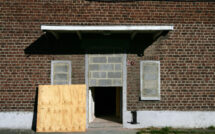

This is part of our special feature, Homelessness and Poverty in Europe.
Poverty is one of the most debated terms in Germany today. Conservatives and neoliberals have wielded it as a political hatchet to invoke the needs of the Global South and deplore the suffering people experience in these countries. For these ideologues, “real” poverty plagues states like Burkina Faso, Bangladesh, or Mozambique, but not Germany. Naturally, the perception that poverty is an external phenomenon limited to developing countries gives politicians in Germany a good conscience and unburdens them from the responsibility to find remedies. Deliberately ignoring the issue of poverty in Germany does not allow for an understanding of a social problem that has been greatly amplified by contemporary economic crises, societal upheaval, and catastrophes such as the pandemic.
However, most German commentators have vehemently denied that poverty exists in their own country, even though it does, albeit in less spectacular and less visible forms than in the Global South (Butterwegge 2016; Lorke 2015). Since the German social insurance system was established in 1945 to guarantee workers and their families fulfillment of their existential needs, the poor in (West) Germany have been defined narrowly as those living the most precarious existence. The term has been used to describe specific groups that lack economic opportunities, in an effort to classify a forms of social inequality of which the Germans are most ashamed.
Being poor in a rich social welfare state
Poverty is a multidimensional problem that encompasses monetary, social, and cultural aspects. In a wealthy country such as the Federal Republic of Germany, being poor means above all:
- Being indigent or ridden with debt due to a limited capacity to work, a dearth of job opportunities, or low wages;
- Experiencing a persistent shortage in the possessions perceived as necessary to lead a more or less “normal” life;
- Being disadvantaged in multiple arenas such as work, housing, leisure, and sport;
- Being excluded from (good) education and from the (high) cultural and social networks that are necessary for social inclusion;
- Facing increased existential risks, health deficiencies, and diminished life expectancy;
- Experiencing a loss of social status and social respect, and by extension frequently losing self-confidence;
- Experiencing powerlessness or the inability to wield influence in all key spheres of society (the economy, politics, governance, knowledge production, and mass media).
It is important to differentiate here between absolute, extreme, or existential poverty on the one hand and relative poverty on the other (Butterwegge 2021). Absolute poverty affects people who cannot meet their basic needs: not enough to eat, no safe drinking water, no appropriate (warm) clothing, no housing, and no access to medical care. Those suffering relative poverty, in contrast, are able to meet their basic needs but cannot afford the extras that others consider normal, such as occasionally eating a restaurant meal or going to the movies or the theater. Moreover, people in this situation participate minimally socially, culturally, and politically. In Germany, absolute poverty mainly takes the form of homelessness. The designation of the “unhoused” (wohnungslos) refers to those who do not own or rent their own living space and who instead live at shelters or bunk with friends or acquaintances. In contrast, the “unsheltered” (obdachlos) are those who live on the streets and, for example, sleep on park benches. The people most at risk of being unhoused or unsheltered and who are truly impoverished are serious drug addicts, “street children”—mostly adolescents—unaccompanied refugee minors, citizens of EU member states with no access to social services, and illegal migrants.
What does it mean to be unhoused or unsheltered in a prosperous—if not rich—country that defines itself as a social welfare state? Alex Füller and Sarah Morr (2021) assume that situations of extreme need have become normal:
Not all unhoused people have the necessary access to the appropriate services. Many unhoused people do not have appropriate identification or a record of previous residence (Meldeadresse); others find the social and linguistic hurdles posed by governmental offices too intimidating (ibid, 68).
Because accurate statistics are difficult to obtain, the number of unhoused and unsheltered people in Germany is much disputed. However, while the poverty rate declined substantially during the 1990s, the number of people in poverty in Germany has risen steadily since the turn of the Millennium. In 2018, the Bundesarbeitsgemeinschaft Wohnungslosenhilfe, the umbrella organization gathering non-profit organizations working to remedy the problem, estimated that there were 678,000 unhoused people in Germany, or 0.8 percent of the population; of those, 441,000 had refugee status (Füller 2021; Morr 2021). Moreover, 41,000 of those people lived on the street; and in many large German cities, almost half of the people living on the street were citizens of the European Union from Eastern member states. Few “vagrants,” as the unhoused used to be called, were holders of German identification papers. However, the number of members of the middle class (Mittelschichtangehörigen) who are on the street has risen, especially among independent contractors, the self-employed, and independent business owners whose businesses have failed.
In the European Union, people at risk of falling into relative poverty have been defined as those disposing of 60 percent or less of the mean (mittleren) household net income. Consequently, in 2021, 14.1 million people were either living in poverty or were at risk of becoming poor in Germany. These people had less than1,145 Euros per month to live on, which is the poverty threshold for a single adult. The segments of society most at risk of becoming poor in 2021 were the unemployed (49.4 percent), single parents (42.3 percent), non-Germans (Nichtdeutsche, 35.9 percent), and members of large families (Mehrkinderfamilien, 32.2 percent). Children and youths, as well as young adults, were also in the high risk category, with 21.3 percent and 25.8 percent respectively, while the risk of poverty for the elderly had increased to 17.6 percent compared to the previous period. Young people have long faced obstacles as they seek affordable living quarters, health care, and leisure and educational opportunities. However, today, seniors find themselves deprived of the rewards of their lifetime of work. Members of this age cohort have become vulnerable to social exclusion, isolation, and loneliness due to declining pension amounts and extremely modest social security benefits. While the income levels of older people have decreased, their financial burden has increased due to the rising costs of the medical and social support they increasingly need.
The effects of the COVID-19 pandemic on inequality in German society
The COVID-19 pandemic, the explosion in energy prices resulting from the war in Ukraine, and the recent increase in inflation have substantially altered the landscape of poverty in Germany, as well as the social structure and notion of welfare state in Germany. On the one hand, the situation has highlighted that, although people in Germany have experienced relatively high living standards since WWII, compared to much of the world, and despite politicians’ insistence that Germany has become a “classless” society that guarantees prosperity for all its citizens, a majority of the population could only manage for a few weeks without regular income. On the other hand, the COVID-19 crisis and the effects of inflation have deepened the chasm between rich and poor. The intense economic displacement the pandemic has caused has exposed the fundamental problem faced by the Federal Republic, namely, the rise in economic and social inequality. Not only is the problem of inequality on people’s minds more than ever, but it has also amplified and reinforced the social polarization processes that have helped cause it in the first place.
The arrival of the SARS-CoV-2 in Germany in January-February 2020 profoundly changed the nation’s economy, society, and state structures. On the one hand, the COVID-19 pandemic initially papered over some longstanding social inequalities and issues politicians had neglected. On the other hand, state-sponsored measures designed to ease the crisis, such as two nation-wide lockdowns and contact and travel restrictions, further deepened social inequality. The resulting recession, in spite of the pandemic aid packages and financial subsidies provided by large employers, had the same effect on inequality. COVID-19 has mostly affected the immuno-compromised and those at the lower end of the social scale. Despite the known dangers posed by the infection and the fact that physicians, epidemiologists, and politicians recommended people “shelter at home,” the unhoused and unsheltered were unable to seek shelter and were also deprived of the usual income they received from selling newspapers, distributing leaflets, or collecting bottles. They could no longer beg either, since the pedestrian traffic decreased and the general public avoided such interactions for fear of infection. These individuals undoubtedly suffered the most from the COVID-19 pandemic; however, neither public attention nor state-sponsored services have focused on these groups to alleviate the crisis. Moreover, during the lockdowns, temporary shelters for refugees became ideal incubators for the virus since several people shared single rooms and were thus unable to maintain safe distances. The collective quarantines implemented at shelters for asylum seekers were a particular problem because non-infected people were forced to share living quarters with people who were ill.
Transfer service recipients (Transferleistungsbezieher/innen) saw their cost of living rise because most food pantries were closed, panic shoppers emptied grocery stores’ shelves of basic foodstuffs such as noodles and flour, and the price of most fresh foods increased. Transfer recipients also did not have the resources to purchase the recommended personal protective gear such as face masks and disinfectants. While many social welfare non-profit organizations recommended that the government offer asylum seekers a monthly bonus of 100 Euros to help them face these increased costs, the national government only approved a one-time payment of 150 Euros, which was released very late, only in May 2021. Nearly 40 percent of food pantries, formerly known as soup kitchens, witnessed up to a 20 percent increase in the number of their patrons.
At the onset of the first lockdown, a large portion of the population, including many member of the middle class, experienced substantial financial problems. While many people got into deeper debt, debt advisers confronted pressures from two sides: as the number of indebted citizens increased, they were in higher demand and needed to spend more time with clients; at the same time, the institutions in charge of providing debt relief services were under pandemic restrictions and had to cope with shortages of personnel. The situation in certain industries was particularly dire. The catastrophic working conditions in the meat industry and the scandalous living conditions of many of its workers attracted widespread public attention in May and June of 2020, as vast slaughterhouses and meat processing facilities such as those owned by Westfleisch in Coesfeld and Tönnies in Rheda-Wiedenbrück became “Corona hotspots.” Many of the workers who tested positive for the virus were Polish, Romanian, and Bulgarian contract workers who toiled and lived in appalling conditions. Consequently, poor people were more likely to die during the pandemic because of their higher risk of infection; moreover, the likelihood of suffering from a severe case of COVID-19 rose proportionally with the degree of individuals’ economic hardship. The risk of infection among the unemployed, the socially dependent, and the poor was markedly higher than among the wealthy. Certainly, the pandemic affected everyone in Germany, but everyone did not suffer equally. Instead, there were important differences driven by (pre-pandemic) working and living conditions and individuals’ existing health.
Socially determined pre-existing conditions, such as obesity, angina pectoris, asthma, chronic obstructive pulmonary disorder (COPD), Type 2 diabetes, disastrous working conditions as well as cramped and unhygienic living conditions increased one’s risk of being infected with the virus and especially of suffering a severe case of the disease. A large majority of the victims were in the low-income category, immunocompromised, unhoused, or unsheltered; they were also migrants without legal status, people with physical and mental challenges, drug addicts, sex workers, un- or underemployed, low-income seniors, and recipients of social welfare benefits. Others were living in communal settings: prison inmates, refugees, and (south)eastern European slaughterhouse and seasonal workers.
Due to monthslong prohibitions on social contact, as well as travel restrictions and business closures, the already strained coping mechanisms of the poorest Germans were completely obliterated, and their impoverishment worsened. If one had no home, it was impossible to remain at home. According to a press notice issued by the aforementioned non-profit Bundesarbeitsgemeinschaft Wohnungslosenhilfe on December 21, 2021, the number of poor people increased during the pandemic. A survey revealed that the number of poor people in Germany had increased by 4.9 percent between 2019 and 2020. On June 30, 2019, circa 151,000 people had no rental contract; by 2020 that number has risen to circa 158,000, and of those, approximately 45,000 were unsheltered, that is, living on the streets.
The disruptions to supply chains unleashed by the coronavirus, the collapse of transport structures, the decline in consumer markets, and the shuttering of schools, businesses, restaurants, hotels, discos, theaters, clubs, and other social venues wreaked financial havoc on the employees working in those places and led to numerous bankruptcies and redundancies. The most deeply affected were those employed in service businesses that required contact with the public and whose employees were already low earners and frequently female. Some obvious businesses in this category include hair and nail salons and fitness studios. The already heavy financial stresses borne by welfare benefit recipients, fixed income pensioners, and refugees also increased.
The deepening of poverty in Germany: recession, energy prices, and inflation
Germany’s socioeconomic polarization has been exacerbated by inflationary prices, chaotic supply chains, rising transport costs and shortages of basic goods and raw materials. Rapidly increasing prices, especially in transport, household energy, and foodstuffs, affected even the lower middle classes, which more or less managed to cope with the earlier pandemic-induced challenges. While many businesses, including large ones, profited greatly from the state’s willingness to increase the national debt, those on the financial margins received only modest compensation compared to the generous lifelines offered to keep big businesses afloat. The billion-Euro bailouts and protections did not help the most vulnerable, whose debts increased and who often ended in situations of personal bankruptcies.
The substantial increase in prices caused by the war in Ukraine and the soaring cost of energy hit the poorest groups the hardest, since these individuals lack any financial cushion. Food pantries, bottle and can exchange services, and debt counselors have barely been able to cope with the demand. Anxieties about the loss of social status has crept into broad sectors of the middle class as well. Energy shortages have led people to spend more than 10 percent of their income on household energy; these shortages have been the result of human actions such as distribution systems. The regressive impact of skyrocketing energy costs caused by Russia’s war against Ukraine and the western sanctions imposed in reaction to the invasion have cemented social inequality in Germany, which state-sponsored “rescue packages” have done little to ameliorate. Instead, it is reasonable to fear that shortages in food and energy will spawn a new social question (Soziale Frage) in the Federal Republic. If price increases persist, many families will be forced to spend half their incomes on heating. The explosion in energy prices and steady increases in rent will likely push the number of evictions much higher. By extension, these evictions will result in an increase in the number of unhoused and unsheltered people, who in 2020 were estimated to represent 45,000 individuals in Germany. If relative poverty were to devolve into absolute, existential, or extreme poverty, need and suffering would become a fixture of Germany’s cityscapes, with increasing numbers of beggars, bottle collectors, and street newspaper vendors. At the same time, people struggling to pay their energy bills have become more numerous, even when their income remains above the official poverty line. People’s struggles are hidden to some degree because there are no official statistics, but rising prices are making it increasingly difficult for people to cover essential household costs. Energy poverty (Energiearmut), which refers to circumstances in which a household spends more than 10 percent of its income on energy, may become the “new normal.” Of great concern is a future where living, energy, and food costs generate never seen levels of impoverishment in Germany, deepening social divisions as a result.
Christoph Butterwegge taught political science at the University of Cologne from 1998 to 2016. His latest publications include Die zerrissene Republik. Wirtschaftliche, soziale und politische Ungleichheit in Deutschland [The Frayed Republic. Economic, Social and Political Inequality in Germany], Ungleichheit in der Klassengesellschaft [Inequality in a Class Society], Kinder der Ungleichheit. Wie sich die Gesellschaft ihrer Zukunft beraubt [Children of Inequality. How Society Has Robbed Itself of the Future], and Die polarisierende Pandemie. Deutschland nach Corona [The Polarizing Pandemic. Germany after Corona].
Translated from the German by Elizabeth B. Jones.
References
Butterwegge, Christoph. 2016 Armut in einem reichen Land. Wie das Problem verharmlost und verdrängt wird, 4. Aufl. Frankfurt am Main/New York: Campus.
Butterwegge, Christoph. 2021 Armut, 5. Aufl. Köln: PapyRossa.
Butterwegge, Christoph.2022 Die polarisierende Pandemie. Deutschland nach Corona, Weinheim/Basel: Beltz Juventa.
Deutscher Paritätischer Wohlfahrtsverband Gesamtverband (Hg.). 2023. Zwischen Pandemie und Inflation.Paritätischer Armutsbericht 2022, aktualisierte 2. Aufl., Berlin, März.
Füller, Alex and Sarah Morr. 2021.Menschen ohne Obdach, Stuttgart: Klett-Cotta.
Lorke, Christoph. 2015. Armut im geteilten Deutschland. Die Wahrnehmung sozialer Randlagen in der Bundesrepublik und der DDR, Frankfurt am Main/New York: Campus.
Published on July 12, 2023.




